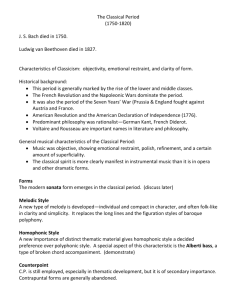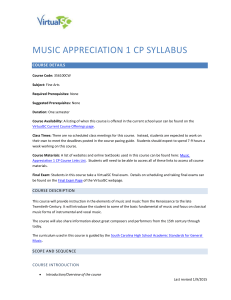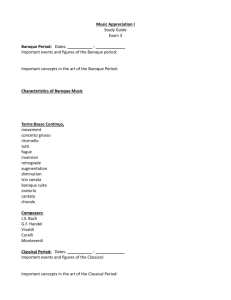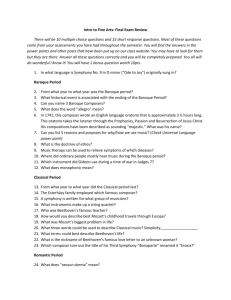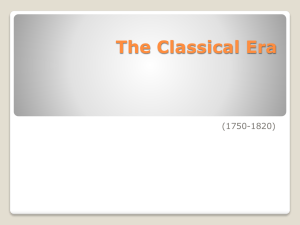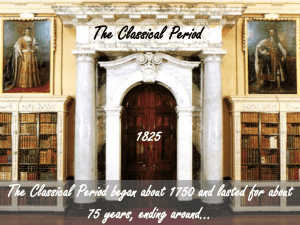File
advertisement
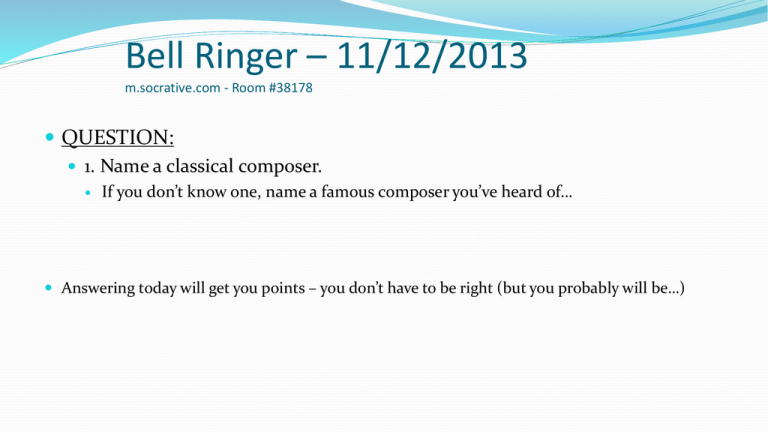
Bell Ringer – 11/12/2013 m.socrative.com - Room #38178 QUESTION: 1. Name a classical composer. If you don’t know one, name a famous composer you’ve heard of… Answering today will get you points – you don’t have to be right (but you probably will be…) The “Enlightenment” NEW TAB – CLASSICAL PERIOD This is a BIG unit – now through December. The Enlightenment - Introduction 18th Century (1700s) The “Age of Enlightenment” A change in styles, philosophies, and politics Art, Music, Dance, and Drama will begin to develop in separate directions at different times The Enlightenment - Introduction Main Themes of 18th century thought: Faith in science Faith in human rights arising from natural law Faith in human reason Faith in progress Progress: the assumption that the conditions of life could only improve with time and that each generation made life even better for those following The Enlightenment - Introduction The age becomes increasingly secular – enlightenment, reason, and progress are secular ideas Politics and business superseded religion Leadership was wrestled away from the Church Religious toleration increased Persecution and the imposition of corporal punishment for religious offense became less popular The Enlightenment - Introduction The “ancient” thought: the works of the Greeks and Romans would never be surpassed The “modern” thought: science, art, literature, and the inventions of their own age were better since they were built upon the achievements of their predecessors New Technology Telescopes and microscopes improved Who invented the telescope?? GALILEO! The invention of the steam engine gave rise to other machines and paved the way for the Industrial Revolution at the end of the 18th century Coal fuel takes the place of charcoal Improvements in iron and steel pave the way for structural improvements in bridges and buildings New Technology The introduction of power machinery revolutionized the English textile in the late 18th century Human, animal, wind, and water power were replaced by machine New Technology Undoubtedly the most significant invention: the STEAM ENGINE First developed in England in 1699 Early steam engines were used to drain mine shafts Some wealthy people were using steam engines to pump domestic water supplies (filter) First successful steam engine locomotive – 1804 Could generate an estimated 1000 horsepower Started the Industrial Revolution Philosophers and Philosophes The Philosophes The Enlightenment was concerned MORE with philosophy than invention Humanitarianism – all men and women had a right, as rational creatures, to dignity and happiness Philosophes: were not philosophers in the usual sense of the word. They were publicists. Pulled thought from great books and translated it into simple terms that could be understood by a reading public The Philosophes - Encyclopedia The most serious of all the philosophe enterprises: Encyclopedia In France Editted by Denis Diderot (1713-84) 70 volumes Took from 1751-1772 to complete Compilation of scientific, technical, and historical knowledge Major contributors – Voltaire and Rousseau Classicism Aesthetics and Classicism Aesthetics: the study of beauty and theory of art Classical influences dating from the Renaissance continued to be important The excavation of the ruins of the Roman city of Pompeii, found virtually intact, in 1748 caused a wave of excitement A “classical education” was considered essential for all members of the upper classes MUSIC CHARACTERISTICS A Review of Terms Concerto: two or more dissimilar musical forces are used – such as one or more soloists playing opposite an orchestra Program Music: illustrates an external idea (music to tell a story) Absolute Music: purely musical ideas (music for the sake of music – opposite of program music) Sonata: any piece played on instruments that’s not a fugue or a concerto Ornamentation – Baroque Idea Mary Had a Little Lamb Ornamented Common Ornaments Mordent – go up or down one note, then back Turn – go up, back, down, and back Trill – quickly move between the note and the note just above Classical Style Music started being composed not only for the aristocracy but to the middle classes as well Mostly absolute music – music simply because it sounds nice Philosophes inspired composers to seek larger audiences Excessive ornamentation and excessive complexity (baroque) as not appealing to a wide audience Classical music will avoid artificial decoration Classical Style There was a move toward order, simplicity, and careful attention to form Classical – rather than neoclassical or classical revival, because although the other arts returned to Greek and Roman prototypes, music had no known classical antecedents to revive. It turned to classical ideals, though not to classical models (because none existed) This period in Drama and Art is referred to as NEOCLASSICAL or “new classical.” They are looking to the Greeks and Romans and making it something new Classical Style Five Basic Characteristics: Variety and Contrast in Mood Major to minor, happy to sad, etc. Flexibility of Rhythm/Tempo Could “push and pull”, speed up or slow down Predominantly Homophonic Texture All parts will work together Memorable Melody Gradual Changes in Dynamics Dynamics didn’t exist before the classical period We’ll look at each of these individually in the next few slides. Classical Style - Characteristics Variety and Contrast in Mood Baroque typically dealt with a single emotion With classical, moods could change within movements or even within themes “theme” in music refers to a recurring melodic idea Could be more gradual or sudden Well controlled, unified, and logical Example: Beethoven’s Moonlight Sonata Classical Style - Characteristics Flexibility of Rhythm Explores a wide variety of rhythms Utilizes unexpected pauses, syncopations, and frequent changes from long to shorter notes (or even slower to faster tempos) Syncopation – a rhythm with accents on the upbeat (in between beats) May be sudden or gradual Example: Mozart – Eine Kleine Nachtmusik Classical Style - Characteristics Predominantly Homophonic Texture Texture is also flexible – with sudden and gradual shifts from one texture to another – but mostly homophonic with all lines working together Simpler texture than Baroque pieces A work may begin homophonically, with a melody and simple accompaniment, and then shift to complex polyphony featuring two simultaneous melodies or melodic fragments among the instruments, back to simple homophony Example: Mozart – Symphony no. 40 Classical Style - Characteristics Memorable Melody Themes tend to be very tuneful and often have a folk or popular flavor (easy to sing) Melodies tend toward balance and symmetry Have two phrases of equal length Phrase – musical sentence, music comes to an ending The second phrase often begins like the first, but ends more decisively Example: Beethoven’s Symphony No. 9 Finale (2:52) Classical Style - Characteristics Gradual Changes in Dynamics The replacement of the harpsichord with the piano The piano was more capable of handling dynamic patterns Crescendo: gradually getting louder Diminuendo: gradually getting softer Example: Beethoven’s 5th Symphony The Classical Orchestra Similar to our orchestra today, minus a few instruments Strings: 1st Violins, 2nd Violins, Violas, Cellos, Basses Woodwinds: 2 Flutes, 2 Oboes, 2 Clarinets, 2 Bassoons Brass: 2 French Horns, 2 Trumpets Percussion: 2 Timpani No Trombones or other percussive instruments yet New addition from Baroque – the clarinet Approximately 30 string players (approx. 40-50 instrumentalist total) Classical Forms - Sonata Change of definition – more specific now Sonata: a piece for… One or two keyboard instruments For another instrument accompanied by keyboard instrument Composition included several movements Example: Beethoven’s Pathetique (mvt. 2) Classical Forms - Symphony The word “symphony” comes from the Latin symphonia meaning “sounding together” A symphony is an extended composition typically lasting between 20 and 45 minutes and exploring the broad range of tone colors and dynamics Example: Beethoven’s Symphony 5 Mvt. 1 – Beginning Mvt. 2 – 7:26 Mvt. 3 – 17:25 Mvt. 4 – 22:48 Classical Forms – Sonata Form Not to be confused with “sonata,” “sonata form” is applied to the first movement of a symphony Three main sections: Exposition – presents the musical themes Development – themes are treated in new ways, developed in different keys Recapitulation – themes return ABA Design When we look at specific symphonies by Mozart and Beethoven over the next week, I will show you how sonata form works Classical Forms – Theme & Variations Theme & Variations Widely used as an independent piece or as one movement of a symphony, sonata, or string quartet The theme is repeated over and over, each time with some change Could be mood, rhythm, dynamics, and so on Example: Mozart “Twinkle Twinkle Little Star” Variations On the Quiz and Test you’ll need to recognize certain famous pieces of music. They will always be ones we’ve gone over in class that have stood the test of time (still very popular today.) Listening Recognition Practice On your paper is a list of pieces you heard today that you’ll need to recognize on the next quiz and test. For today, simply write the number next to what you think is being played. Once we study these pieces more closely over the next few days, I’ll ask you to match the composer with the title. We will add a few more.
